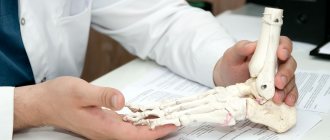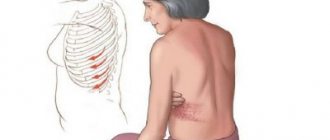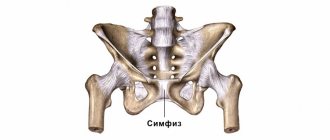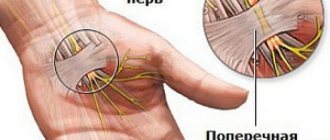In addition, the appearance of edema may indicate the presence of fungal or infectious diseases. When blood flow in the lower extremities is disrupted, blood begins to accumulate, which leads to swelling of the toe and its pain. Sometimes such problems can arise due to an ingrown toenail, but then the entire foot begins to swell along with the toes. Only the attending physician can eradicate the source of the disease. By removing part of the ingrown toenail, the symptoms will immediately disappear.
The presence of a splinter or thorn in a finger can also cause your toes to swell and hurt. After all, the infectious process can begin when a foreign body enters the finger. First of all, you need to figure out what caused the swelling of your fingers and begin to immediately take measures to eliminate them.
What diseases cause swelling in the toes?
Various types of diseases can also cause pain and swelling. These include pathologies such as:
1. Arthritis. An increase in size and limited mobility of one or more fingers may indicate the appearance of this disease, which causes degenerative disorders in cartilage tissue. The development of arthritis is provoked by the presence of excess weight in people, flat feet, and heavy physical work. It is not surprising that athletes often have swollen lower limbs, as they regularly receive injuries, bruises and sprains. At the second stage of development of the pathology, damage to the joints of the fingers occurs, so any delay entails great consequences. Without proper treatment, the patient's condition will worsen, ultimately leading to disability. You should immediately consult a doctor and undergo a full physical examination if you experience swelling and pain in your big toe.
2. Arthrosis. One of the most common symptoms of this disease is swelling of the toe near the nail. This joint pathology is characterized by a destructive effect on cartilage. At the beginning of the disease, the pain is periodic, but eventually becomes chronic. Osteoarthritis often begins with pain in the big toe, which disappears with rest. In the morning, patients experience a certain degree of stiffness, difficult functioning of the joints, as well as a crunching sensation. Signs of arthrosis such as limited mobility and chronic pain overlap with the symptoms of subchondral sclerosis and epicondylitis. If an infection appears in the joints, then arthrosis becomes infectious.
3. Osteoporosis. With the development of this disease, bones lose strength and mass, which is due to pathological processes that make bone tissue fragile and cause swelling. Patients with osteoporosis should treat their fingers carefully and with caution, because any careless movement can lead to a fracture. At the beginning of the development of the pathology, the toe swells and begins to hurt, and after a while deformation occurs with the foot.
4. Symptoms when the joint of the big toe is swollen and painful, and also red, may indicate the development of a disease such as bursitis. Severe bruises and advanced stages of arthrosis can cause its appearance. When a joint is affected, the space between the bones and muscles becomes inflamed and filled with fluid. If the pathology is not treated, the disease becomes chronic and the pain becomes permanent. To confirm the diagnosis, the patient undergoes a fluid tap, MRI, and x-ray in addition to a visual examination.
5. The development of gout can be caused by a malfunction of metabolic processes in the body. This pathology is more common among men than women. At the initial stage of the pathology, the toes swell, and later the phalanges of the fingers can completely collapse. Swelling and pain are paroxysmal in nature
6. Ankle injury. When there is a lot of stress on the legs, the most vulnerable place is the little toe. For example, it can be damaged by hitting a furniture leg or door frame, or by wearing tight shoes. After the blow, the little finger begins to swell and hurt. In general, bruises do not pose any danger to humans. However, the negative impact can manifest itself in the form of chronic pain or the development of not the most pleasant diseases. If after the blow the finger is swollen and painful, then it is necessary to undergo a medical examination.
7. Swelling of the fingers can also be caused by an allergic reaction. If the legs are constantly itching, itching and discomfort appears, then the human immune system begins to react to irritating factors and produce chemicals that cause swelling. All symptoms will go away only if the external irritant is neutralized.
8. Diabetes mellitus. Swelling of the legs in this disease is provoked by metabolic disorders. Typically, patients experience pain and blue toes. In addition, the sensitivity of the lower extremities decreases, there is numbness in the fingers and a burning sensation in the feet. If such symptoms are observed, you should immediately contact an endocrinologist so that the doctor can conduct an examination and prescribe the most appropriate treatment.
9. Panaritium. This pathology appears due to infectious infection. The symptoms are clearly visible, which begin with suppuration of the nail, are characterized by pain and swelling of the finger, and cysts with purulent contents form. A blister and swelling may be seen on the phalanx. In addition, sensitivity disturbances and capillary blockage occur. In this case, herbal baths can help, but the disease can be completely cured only after opening the cysts and completely removing the purulent contents.
Metatarsalgia of the foot
Metatarsalgia of the foot: characteristics and how it manifests itself
Metatarsalgia of the foot is considered a symptom of many foot diseases. This condition is characterized by pain in the metatarsal part of the foot, namely in the toes. The disease is defined by pain at the base of the second, third and fourth toes on the side of the sole.
Causes
The human foot has a complex structure. It consists of small bones, muscles, soft tissues, which are connected by joints. With any type of movement, the foot carries a significant load, because takes on the weight of a person. Pain occurs when there is a sufficiently strong load on this part of the leg. Symptoms develop if any bone is unable to perform its function.
Main provoking factors:
- Inconvenient, constricting footwear;
- Playing sports (mainly running or tennis);
- Excess weight;
- flat feet;
- Injuries.
Metatarsalgia occurs predominantly in older women. The reasons are considered to be age-related bone changes and menopause. In men, this condition is extremely rare.
Diabetes mellitus is also an important factor in the development of the disease. Pain syndrome can manifest itself long before the integrity of human skin is damaged.
Signs and symptoms
The main rather pronounced symptom of metatarsalgia syndrome is pain in the metatarsus (midfoot). The painful sensation has a different character. It may bother the patient when walking, intensify during exercise, or accompany him constantly.
Signs of matetarsalgia syndrome:
- pain and discomfort in the feet;
- feeling of stiffness even in comfortable shoes;
- numbness and tingling of the skin in the foot area;
- pain at the base of the toes;
- after rest or physical activity there is swelling.
Sometimes, metatarsalgia syndrome has visual lesions of the foot, such as Morton's neuroma. It is a small bulge, and upon palpation it causes discomfort. Morton's neuroma manifests itself only on one limb, which significantly affects the diagnosis of the causes of pain in the foot area.
Diagnostics
Initially, upon examination, the doctor determines the increase in pain when pressing on the second, third and fourth fingers at their base.
To make an accurate diagnosis, it is necessary to take an x-ray. This type of study helps to identify changes in the bones of the foot.
When diagnosis is difficult, MRI and CT are more informative methods. They, unlike x-rays, allow you to examine minor damage. The pictures show the condition of bones, nerves and blood vessels.
Treatment
Treatment of metatarsalgia is carried out in the traumatology department and consists of a set of measures aimed at relieving inflammation and pain. In most cases, conservative treatment is sufficient and surgery is not required.
Surgery is prescribed for bone fractures or in cases of advanced Morton's disease. Also, additional procedures help improve blood circulation and innervation of foot tissues. At the end of the course of procedures, it is recommended to adhere to basic preventive measures.
Drug treatment
External preparations, such as ointments, gels and creams, are the basis for effective treatment of metatarsalgia. Such drugs belong to different pharmacological groups and can have different effects. Anti-inflammatory and painkillers are also used in the form of tablets and powders. They are selected individually, based on the causes of pain and clinical signs.
Groups of medications used to treat foot pain:
- steroidal anti-inflammatory drugs (Diprospan, Hydrocortisol);
- non-steroidal anti-inflammatory drugs (Voltaren, Diclofenac, Nurofen, Dolobene);
- warming agents (Finalgon, Apizartron);
- chondroprotectors, which perform the function of protecting cartilage.
Ointments and tablets with an anti-inflammatory effect help influence the inflammation process. If there is no result, then strong hormonal drugs can relieve acute joint pain
feet. Their action is similar to human adrenal hormones. Only a specialist can prescribe such medications.
Also, ointments and warming agents will be useful during periods of acute inflammation. They help relieve swelling and stimulate blood circulation.
Additional course of procedures
It is recommended to perform some exercises that strengthen the muscles and ligaments of the feet. Certain methods allow you to maintain the anatomically correct position of the bones and protect them:
- walking barefoot on uneven surfaces or special massage mats;
- rolling a small ball with your feet;
- transferring weight from toe to heel in a standing position;
- lifting small objects with your toes.
The doctor may also prescribe physical therapy, such as ultrasound treatment, acupuncture or magnetic radiation. Depending on the degree of pain, a certain course of procedures takes about two weeks or more.
Prevention
Hippocrates said: “Disease is easier to prevent than to cure.”
Preventing diseases of various structures in the foot area is much easier than treating them. You should take care of the health of your own feet in advance by applying important rules:
- Wear comfortable shoes that fit your size;
- Monitor your weight;
- Adhere to proper nutrition, as harmful foods have a negative effect on blood vessels, which contributes to the deterioration of blood circulation in the distal parts of the extremities;
- Proper exercise, or rather a reasonable distribution of the load.
Author: K.M.N., Academician of the Russian Academy of Medical Sciences M.A. Bobyr
Which doctor should I contact?
To determine the reason why your toe hurts and is swollen, as well as to treat this problem, you need to consult a doctor. The first step is to visit a therapist, who can prescribe treatment or refer you to a more highly qualified specialist. Swelling of the extremities can also be caused by heart disease, therefore, to exclude this cause, the patient should be examined by a surgeon or rheumatologist. An orthopedist will help solve the problem of foot deformities, and an endocrinologist will prescribe treatment for hormonal imbalances. If the condition is the result of an injury, then you should visit a traumatologist who will identify the essence of the problem. An accurate diagnosis and treatment are possible only after studying the symptoms of the disease and analyzing the patient’s condition.
Before a consultation with a doctor is scheduled, you can relieve the pain on your own. To prevent your toes from hurting, you can apply heat or cold to them (when they burn and turn red). At home, you can use both medications and traditional medicine.
Fracture or dislocation
Fractures and dislocations of the phalanges of the lower extremities may be responsible for pain in the ring finger area. A person feels strange sensations in his toes, the pain intensifies with movement. It is recommended to take an x-ray of the toes, the doctor will prescribe appropriate treatment.
During recovery, reduce the load on the sore leg. In case of dislocation or fracture, an elastic bandage or plaster is applied to the sore finger. The bandage requires regular changes. Dressings are done independently or with the help of a doctor. The cast is removed in the hospital after the required period of time.
How to prevent the disease
Basic preventive measures help prevent swelling in the toes. You just need to take care of your body and try to avoid the possibility of injury. The key to good foot health will be personal hygiene, which should be present in every person's life on an ongoing basis.
Particular attention should be paid to the choice of comfortable, high-quality shoes, which should be made from natural materials, and also have a not very high heel and a comfortable sole. In addition, you can use special orthopedic shoes or insoles. If fungal or other diseases are detected, treatment should be started immediately.
You should also monitor your diet so that it is complete and includes all the necessary microelements obtained from foods. It is necessary to reduce the amount of salt consumed, as it prevents excess water from leaving the body, which causes edema. It is also better to abstain from drinking alcohol or reduce it to a minimum.
Swelling of the fingers is easy to treat and is often completely eliminated, but only if treatment was provided in a timely manner. By following basic rules, you can prevent the formation of edema and also maintain your health.
Plantar fasciitis
Plantar fasciitis is an inflammation of the ligaments of the foot. Women are more likely to experience toe pain because they wear high-heeled shoes, increasing pressure on the nerves in the feet. A dull aching pain with fasciitis occurs at the base of the fingers and is localized at the middle and ring toes.
Inflammation of the foot ligaments
Standing work and long walking aggravate the symptoms of the disease. In case of such pain, give your legs more rest, try not to carry heavy objects. Doctors advise doing an ice massage, applying ice to the soles of your feet, and massaging the skin of your feet. Ultrasound treatment of the finger helps.










